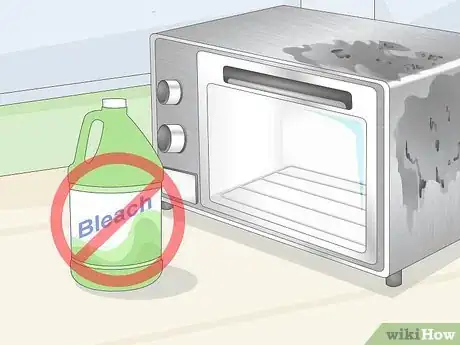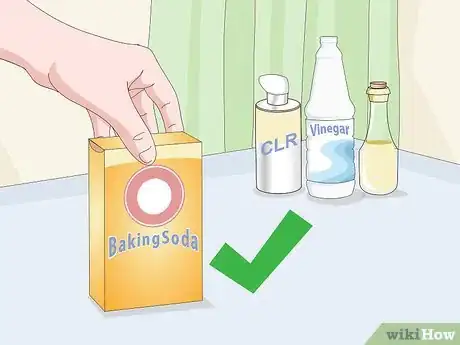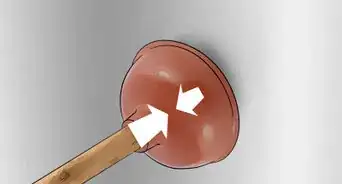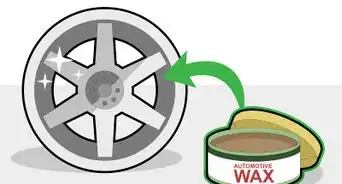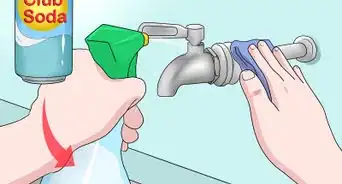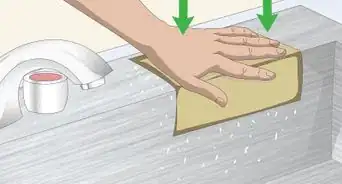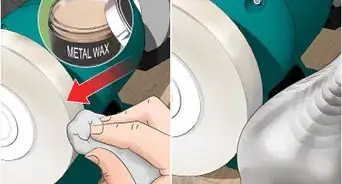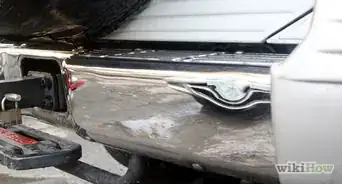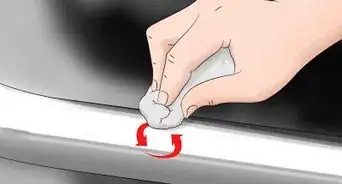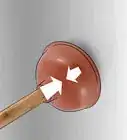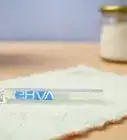This article was co-authored by Susan Stocker. Susan Stocker runs and owns Susan’s Green Cleaning, the #1 Green Cleaning Company in Seattle. She is well known in the region for outstanding customer service protocols — winning the 2017 Better Business Torch Award for Ethics & Integrity —and her energetic support of green cleaning practices.
There are 8 references cited in this article, which can be found at the bottom of the page.
This article has been viewed 74,063 times.
Cleaning brushed stainless steel isn't that different from cleaning regular stainless steel. You can use water for basic spills, and then try a few other household cleaners or homemade cleaners for tougher stains. Whatever you do, be sure to read the manual that came with the item if possible, as it may have specific instructions for cleaning that particular item.[1]
Steps
Cleaning Up Basic Spills
-
1
-
2Wipe in the direction of the grain. If you look closely at the surface of brushed stainless steel, you'll notice it has a grain. It's important to wipe with the grain, rather than against it. If you wipe against the grain, you can end up damaging the surface.[4]Advertisement
-
3Avoid abrasiveness. Anything that's too abrasive can scratch the surface of brushed stainless steel. That includes abrasive sponges and steel wool, but it also includes very hard water or gritty (dirty) water.[5]
-
4
Using Professional Products
-
1Try stainless-steel specific products. Many products on the market are designed specifically for stainless steel. Because they are designed for stainless steel, they are more likely to keep your appliances looking sparkling.[7]
- You could try CLR for stainless steel, for instance.
-
2Use a glass cleaner. In some cases, a glass cleaner with ammonia may work on spills. Make sure to check for bleach before using them, as you don't want to apply bleach to stainless steel.[8]
-
3Skip products with chloride. Products with chloride in them can be harmful to the surface of stainless steel, particularly brushed stainless steel. Therefore, you should avoid cleaners with bleach when working on these surfaces.[9]
-
4Avoid oven cleaners. If the area is extra greasy or on the oven, you might be tempted to use an oven cleaner. However, oven cleaners are too abrasive for brushed stainless steel, so avoid applying them to this surface.[10]
Using Simple Solutions
-
1Use dish soap and water. One way to keep your brushed stainless steel sparkling is to wipe it down often with a little soap and water. In fact, if you wipe it down when you're cooking or doing dishes, it will help you maintain the surface. Wipe off any soap when you're done, though, as you should only leave water on the surface.[11]
-
2Try vinegar. Vinegar is a good natural solution for brushed stainless steel. Use a spray bottle to apply white vinegar to the surface. Follow up with a soft cloth, such as microfiber, always wiping in the direction of the grain.[12]
-
3
Maintaining Brushed Stainless Steel
-
1Rinse the surface after using a cleaner. No matter what product you use, make sure you rinse it off when you're done. You don't want any product to sit on the surface of the stainless steel, as it could damage the surface over time.[15]
-
2Dry the surface thoroughly. When water is left on brushed stainless steel, it can leave water stains on the surface. Therefore, use a soft cloth to dry off the water when you're done rinsing.[16]
-
3Add an oil for polish. Mineral oil or olive oil are a good choice for this step. Oil helps polish the steel when you're done cleaning. It also protects the surface. Rub a little oil on with a soft cloth, making sure to wipe off any extra.[17]
- You can use an oil any time you clean your stainless steel, particularly if you're deep cleaning.
-
4Stick to one cleaner type. You may be tempted to switch cleaners based on what's cheapest or what you have on hand. However, when it comes to stainless steel, it's best to stick to just one cleaner over time, as you won't have cleaners working against each other.[18]
Expert Q&A
Did you know you can get expert answers for this article?
Unlock expert answers by supporting wikiHow
-
QuestionWhat is the best cleaner for stainless steel?
 Susan StockerSusan Stocker runs and owns Susan’s Green Cleaning, the #1 Green Cleaning Company in Seattle. She is well known in the region for outstanding customer service protocols — winning the 2017 Better Business Torch Award for Ethics & Integrity —and her energetic support of green cleaning practices.
Susan StockerSusan Stocker runs and owns Susan’s Green Cleaning, the #1 Green Cleaning Company in Seattle. She is well known in the region for outstanding customer service protocols — winning the 2017 Better Business Torch Award for Ethics & Integrity —and her energetic support of green cleaning practices.
House Cleaning Professional
-
QuestionHow do you polish brushed stainless steel?
 Susan StockerSusan Stocker runs and owns Susan’s Green Cleaning, the #1 Green Cleaning Company in Seattle. She is well known in the region for outstanding customer service protocols — winning the 2017 Better Business Torch Award for Ethics & Integrity —and her energetic support of green cleaning practices.
Susan StockerSusan Stocker runs and owns Susan’s Green Cleaning, the #1 Green Cleaning Company in Seattle. She is well known in the region for outstanding customer service protocols — winning the 2017 Better Business Torch Award for Ethics & Integrity —and her energetic support of green cleaning practices.
House Cleaning Professional
-
QuestionHow can I determine whether my dining room chair frames are brushed steel, stainless steel, chrome, or something related?
 Community AnswerA brushed surface is not likely to be chrome. It is most likely stainless steel, as ordinary steel would be expected to rust eventually.
Community AnswerA brushed surface is not likely to be chrome. It is most likely stainless steel, as ordinary steel would be expected to rust eventually.
References
- ↑ https://www.bobvila.com/articles/how-to-clean-stainless-steel/#.WQFuKsa1vIV
- ↑ http://www.ssina.com/download_a_file/cleaning.pdf
- ↑ Susan Stocker. Cleaning Guru. Expert Interview. 8 November 2019.
- ↑ https://www.houzz.com/ideabooks/51225359/list/how-to-clean-stainless-steel-appliances-and-surfaces
- ↑ https://www.bobvila.com/articles/how-to-clean-stainless-steel/#.WQFuKsa1vIV
- ↑ https://www.bobvila.com/articles/how-to-clean-stainless-steel/#.WQFuKsa1vIV
- ↑ Susan Stocker. Cleaning Guru. Expert Interview. 8 November 2019.
- ↑ https://www.houzz.com/ideabooks/51225359/list/how-to-clean-stainless-steel-appliances-and-surfaces
- ↑ https://www.houzz.com/ideabooks/51225359/list/how-to-clean-stainless-steel-appliances-and-surfaces
- ↑ https://www.bobvila.com/articles/how-to-clean-stainless-steel/#.WQFuKsa1vIV
- ↑ https://www.bobvila.com/articles/how-to-clean-stainless-steel/#.WQF0qsa1vIW
- ↑ https://www.thekitchn.com/how-to-clean-stainless-steel-appliances-with-vinegar-and-oil-cleaning-lessons-from-the-kitchn-205232
- ↑ https://www.houzz.com/ideabooks/51225359/list/how-to-clean-stainless-steel-appliances-and-surfaces
- ↑ https://www.bobvila.com/articles/how-to-clean-stainless-steel/#.WQF0qsa1vIW
- ↑ https://www.bobvila.com/articles/how-to-clean-stainless-steel/#.WQF0qsa1vIW
- ↑ https://www.bobvila.com/articles/how-to-clean-stainless-steel/#.WQF0qsa1vIW
- ↑ Susan Stocker. Cleaning Guru. Expert Interview. 8 November 2019.
- ↑ https://www.houzz.com/ideabooks/51225359/list/how-to-clean-stainless-steel-appliances-and-surfaces
About This Article
To clean brushed stainless steel, wipe it down regularly with dish soap and water. Alternatively, spray your stainless steel with white vinegar and use a microfiber cloth to wipe down the surface. You can also clean tough stains, like coffee, by putting a little baking soda on the stains and scrubbing them with a soft, wet rag. No matter which method you use, make sure to wipe your stainless steel in the direction of the grain. Then, rinse it off with water and dry it completely with a soft cloth to avoid damaging the surface. For more tips, including how to use professional products to clean your stainless steel, scroll down!







